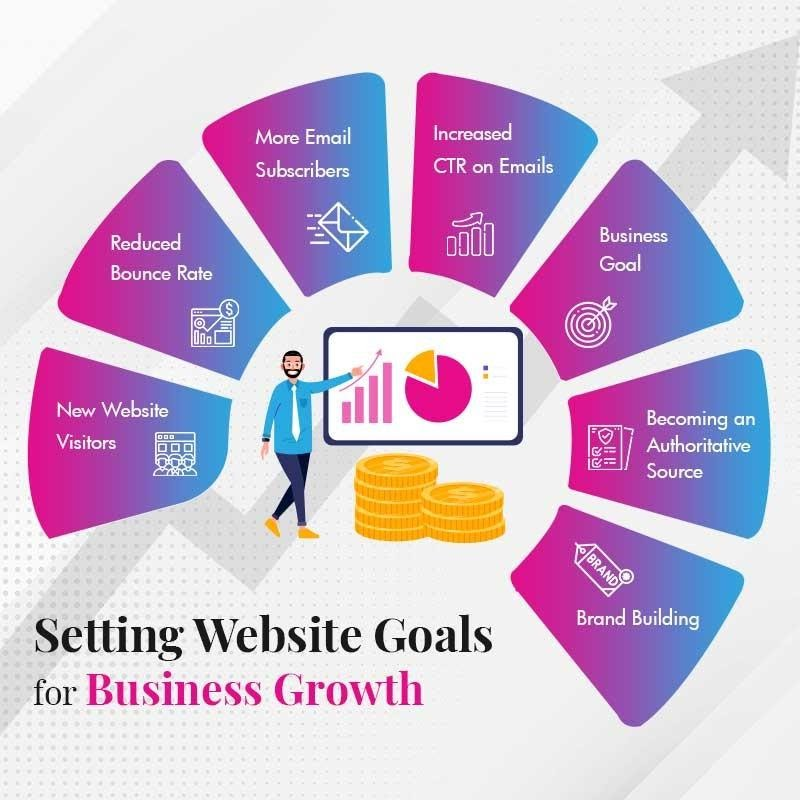
Setting a goal while creating a website is important as it will keep you on track and optimize your efforts in the right direction. Depending on your goal, you need to measure different metrics and optimize the site accordingly. As you can understand, your website goal will directly impact your business.
Setting realistic goals is important here. If you are just designing a website and your goal is to outgrow Amazon, you may be frustrated in a day or two! On the other hand, setting too easy a goal will limit your potential. No worry, we are here to outline some unique and attainable goals that encourage your business growth.
Set and Meet Website Goals: An Actionable Strategy
Goal #1: New Website Visitors
More traffic means more opportunity, more sales, and more subscribers. If 200 visitors generate $300 income, 800 visitors may generate $1200. Of course, the calculation is simplistic and we have not taken bounce rate into account. But it sure gives you a rough idea, right?
How to Achieve?
The first step is to optimize your site for the search engine. A study by Leverage Marketing found that almost 95% of web traffic checks only the first search engine result page. This underlines the importance of occupying a place on the SERP.
Not only search engine optimization, but you can also drive more traffic by engaging full-scale digital marketing services. The marketers will run PPC campaigns, promote your business on social media in order to drive people to your site.
How to Measure?
Set up a Google Analytics account. Set the date range as “last month” and check the number of users you acquired.
Goal #2: Reduced Bounce Rate
Now, it’s not enough to drive traffic but retaining them for a long time is equally, or perhaps, more important. For that, you have to aim at reducing the bounce rate.
How to Achieve?
Multiple things may lead to increasing the bounce rate including slow loading speed, unappealing layout, confusing content, and so on. Our first advice is to engage a professional website design companywhile building the site. With due experience and expertise, the professionals will create a user engaging website.
How to Measure?
You can check the bounce rate right from Google Analytics. Try to aim for 50% or below.
Goal #3: More Email Subscribers
More email subscriptions indicate that your campaigns will reach more users. It may compel them to visit your website and convert. You can directly communicate with them in the email inbox.
How to achieve?
Place email subscription boxes on every page, more than once if required. You can use a side panel or pop-ups for the users to subscribe. Incentives like eBooks, free courses, coupons, etc. can encourage people to subscribe.
How to Measure?
Set up a MailChimp, Campaign Monitor, or AWeber account. These will enable you to keep a track of your subscriber, monitor growth, and send template newsletters to multiple recipients at once.
Goal #4: Increased CTR on Emails
It’s not enough to creating and sending emails randomly. If you want to accomplish a goal, you need to be minute about the impact of your efforts. Otherwise, you will only drain your resources. Therefore, monitor the click-through rate of the emails.
How to Achieve?
Write an attractive subject line that encourages people to open the email. Instead of writing what you are offering, mention how it will help the recipients. Here are two examples:
- Our Health Insurance Policies for Hospitalization Expense
- Your hospital bills can be Reduced by 60%
Which one, do you think, will receive more open rates? The second one! Get the difference?
Some other strategies include using the subscribers’ first name, offering a discount that leads people to the website, and so on.
How to Measure?
You can use a email manager tool (ex: – MailChimp) to track the click-through rate. Depending on the report, make sure to modify your strategies from time to time.
Goal #5: Business Goal
The aim of your website is to meet your business objective. Pay attention to increased conversions. Depending on your website, it may include increased sales, downloads, or calls/messages.
How to Achieve?
It’s time to A/B test the CTAs (Call-to-Actions). Check which CTAs are driving the most clicks. Also, pay attention to creating an uncluttered website with meaningful and engaging content. Experiment with new images and customized copies. Offering discounts also positively impact your sales.
How to Measure?
You can monitor user behavior across your website right from the Google Analytics tool. If you have an e-store built with Shopify or BigCommerce, you can monitor the data from their order performance reports.
Goal #6: Becoming an Authoritative Source
If you aim at becoming a go-to destination for finding information in a specific niche, you need to adopt distinct strategies for your website.
How to Achieve?
Add new and authentic information, publish high-quality blogs, and promote your site through guest posting. Backlinks from high DA (Domain Authority) portals intimate search engines that your site is a trusted one.
How to Measure?
Find out how many people visit your site or subscribe to your newsletter. Further, you can use Mentions.com to check which posts have mentioned you (but not hyperlinked).
Goal #7: Brand Building
Your website is a part of your brand. If you have a bigger picture of becoming a large brand in the coming times, it starts with your website.
How to Achieve?
Other than offering user engaging and informative content, pay attention to promotions, reputation management, and customer service. Integrating live chat support can help to offer instant customer service. Further, if you target multiple locations, languages, or demography it’s important to customize various elements (say, colour scheme, language, content, campaigns, etc.) on or beyond your website.
How to Measure?
Keep an eye on how your effort is sprouting results. If you see some campaigns are not working, it’s time to plan something new.
Summing Up
Setting a realistic goal will help you to step up the ladder and make the most of your investment. Don’t get overwhelmed. Take small steps to execute a large plan. We hope that our blog has helped you to segment a broad goal into multiple short goals. Implement these and thank us later!



